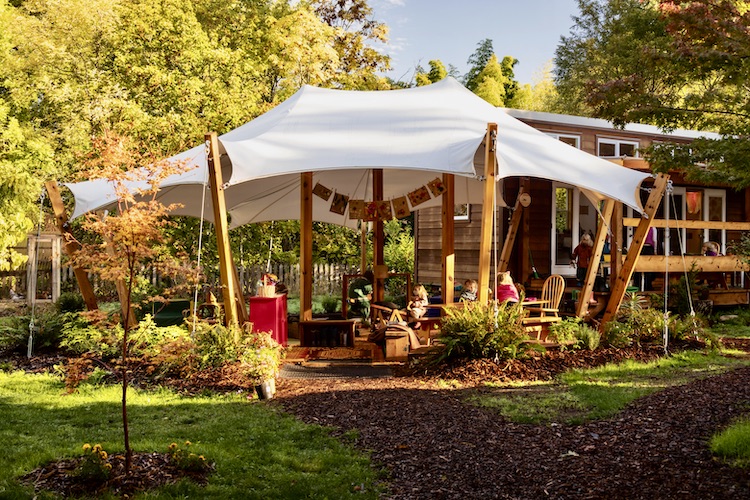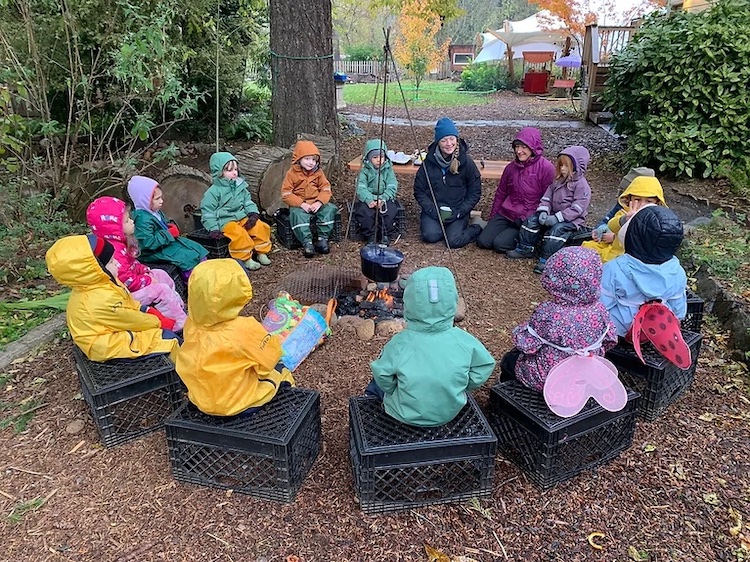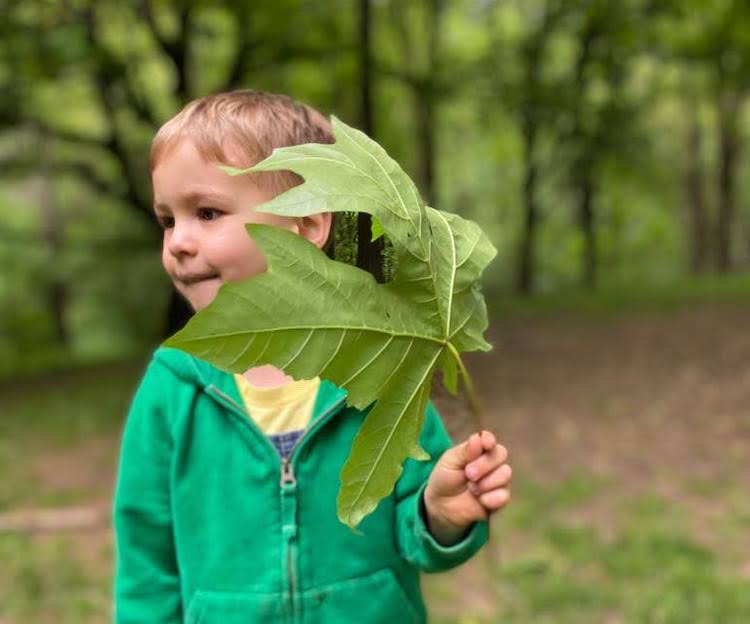Find out what local parents are saying about the benefits, challenges and joys of outdoor preschool.

Wander the rainy streets of our city long enough and you’re likely to see small children bundled up in rain gear, climbing on playgrounds and stomping through mud puddles. It’s no secret that Portlanders of all ages love the outdoors — no matter the weather. But what if your kiddo could be outside year-round, for hours each day, learning and growing in their confidence?
Portland has a growing number of schools that let children do just that, starting with preschoolers. Here’s how outdoor preschools operate, the benefits and drawbacks, and what families love most about these nontraditional schools.
What is outdoor preschool, and what are the benefits?

As you might expect, outdoor preschool takes place almost exclusively outdoors. It encourages children’s physical, social and emotional growth. Children gain an appreciation and understanding of the natural world. There are also similarities to more traditional schools. Most outdoor schools offer snack time (and lunch, if school takes place in the afternoon), have access to private bathrooms, and many even do a structured circle time. But there are differences as well.
Many outdoor preschools foster child-led learning. “We’re allowing kids to be able to say what they want to be doing,” says Sara Murphy, a teacher at Little House Nature Preschool and Kindergarten in Milwaukie. “We have an idea of what our day looks like, but we’re adapting it to the kids and allowing them to really be kids.”
Outdoor preschool follows the childrens’ natural rhythms and interests, which can lead to greater confidence. “Children get physically confident in their own bodies, and this extends to their social confidence,” says Murphy. “When they feel like they know how to scramble up a hill or take all their layers on and off by themselves, then we see those same kids grow in their ability to advocate for themselves. … We see the connection between their body development and their sense of self-efficacy, and what they can change in the world.”
“It’s really powerful to watch,” says Hana Bressler, director and teacher at Portland Outdoor Forest Preschool. Students at Portland Outdoor Forest Preschool, based in Washington Park, attend school from 9 am to 1 pm; the preschool also offers a summer program.
“We wish more parents knew about the benefits,” adds Christine Goodale, teacher and director of Little House, which offers a morning preschool program from 8:30 am to noon, or an afternoon option for pre-K and kindergarten from 1 pm to 4 pm, and runs on an 11-month term from September to July.
The school, located in Milwaukie, looks like a forested wonderland. There are children running, playing and laughing in a wooded area. There are chickens and bunnies, which the children help feed and take care of. Little House also features a large garden space, a mud hill and a partially covered play area called the Cloud Room set up with wooden furniture, colorful rugs, books and toys (pictured above).
Goodale says the Cloud Room is often used as a “transition space,” noting that kids sometimes need time to adjust before playing entirely outside. It’s also a good space for when it’s pouring, but even then, many kids still prefer to play and run outside.
Another benefit to outdoor education is that it teaches children about the natural world and encourages observation. “There’s a lot you can observe and learn being outdoors,” Goodale says. “We’re often out here and the kids are noticing an eagle flying by, so we observe it. A lot of what we do is whatever is inspiring us at the moment based on what’s happening in the world.”
Bressler emphasizes this as well. “We’re studying weather systems. We’re studying how this plant interacts with this other plant. We’re studying different kinds of animals that live in the area. Instead of looking something up on the internet and trying to make a science project in class, we get to actually catch the salamander and study it and see how it moves.”
What do parents and kids think about outdoor preschool?

Local parent Emily (who preferred not to have her last name published) says outdoor preschool has been regulating for her 4-year-old daughter Hazel. Hazel attends the preschool program at Premier NW Kids Forest School in Vancouver, Washington, which offers a half-day program during the school year. “I feel like she learns and interacts best with her peers outdoors,” she says about Hazel’s experiences. “She can be a little sound sensitive when other kids are loud inside, but it doesn’t bother her outside, so this seems to really help her relax and enjoy playing, even with rambunctious kids.”
Several parents mentioned the peacefulness and tranquility, as well as how beneficial outdoor school has been for kids who have had a difficult time acclimating to more traditional school structures, due to the pandemic or other reasons.
Another bonus? Children who attend preschool outdoors get sick less often than their indoor classroom peers. “I love that she’s never gotten sick from school,” says Emily.
Cassie Capone, whose child Brooks attended Little House for two years from the ages of 3 to 5, says that Brooks, “thrived and would often come home beaming and telling me about the chickens and bunnies, or point out edible plants as we walked around our neighborhood.”
Kristen Hirte, whose 4-year-old currently attends Little House, says, “To have our son come home muddy, tired and smiling and talking about how he got to feed the bunnies with carrots he helped grow in the garden, and how they’re making muffins with the eggs that they collected from the chickens. It’s just so incredibly fulfilling. They’re learning skills that are unique — and yet so fundamental to what this generation needs to get back in touch with.”
But what about the challenges?

No one denies that there are also challenges to being outdoors. Our longer, hotter summers can pose difficulties. And the cold and rain can grow tiresome — but there are also ways to overcome those issues. “We wear a lot of gear,” says Bressler. “We think a lot about terrain, about hazards in the forest and how to mitigate risk. We work closely with [Washington Park] arborists to make sure everything is safe.”
At Little House, the kids bundle up in layers, too. But they also have a small, sauna-like enclosed room with a heater used as a warming station. Goodale adds that they also warm rocks and put them inside mittens, which the children can hold. And while Premier NW Kids Forest School is entirely outdoors, with no covered space, teachers have taught students similar tricks as well, like “tucking hand warmers inside mittens, and making sure the rain suit is over the boot not tucked into it.” When you’re outside, small tricks like this can go a long way.
Outdoor school may be a great fit for children with certain conditions — such as sensory-processing disorders — but potentially not for students who are in wheelchairs or have other physical disabilities. While teachers acknowledge each child has different needs, they are open to finding solutions. “One size does not fit all and we would love to discuss accommodations for your family,” says Bressler.
Hirte adds that another challenge can be “learning in an environment that doesn’t have any walls.” For instance, it can sometimes be difficult for children to do circle time when there’s no formal classroom. “You can’t always just take off for the woods, right?” says Hirte, with a laugh. But she adds that the teachers have been incredible at troubleshooting with parents, and that things like arriving early to walk around can help tremendously.
In the end, even the challenges offer an opportunity to stay present. “It’s about finding joy in whatever is happening,” says Murphy.
What about parents who still have hesitations?
For parents thinking about enrolling their child at an outdoor preschool, Hirte recommends taking a tour. “And if that’s not enough, ask for a second tour!”
Like most schools, outdoor preschools typically offer a chance to meet with the director and teachers, and to tour the school to learn more. Bressler says Portland Outdoor Forest Preschool also offers field days that are open to the public, where parents can come see how they operate. They generally do about six per year.
Parents describe outdoor preschool as a magical experience. But can words alone do it justice?
“The feeling you get seeing your kid come home having that experience day after day after day,” says Hirte. “It’s indescribable.”
For helpful information about even more Portland preschools, check out our comprehensive guide!
- Portland Preschools Where Kids Learn Outdoors - February 13, 2024
- Top 5 Picks for Sick Days - December 26, 2023
- Allergy-Friendly Dining With Kids - December 19, 2023






